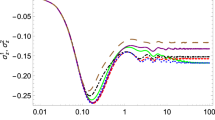Abstract
The dynamics of open quantum systems are described using a set of operators called Kraus operators. In this paper, we show how to find system parameters for a closed system of two qubits undergoing quantum multiplexer operations such that Kraus operators can be written for a single open qubit system (the target qubit) when the initial density matrix of the joint system is in any arbitrary mixed state. The strategy used is to extend the single-qubit open system to a larger two-qubit closed system, which can evolve using unitary dynamics. The constructed two-qubit system is evolved using quantum multiplexer operations, and system parameters are derived to implement the operation. To derive the parameters, we use a reduced Hamiltonian technique wherein the qubit of interest (the target) evolves only in subspaces of the second qubit (the control). The main advantage of our scheme is that it is not restricted to separable product states and/or local unitary evolution of the joint system.



Similar content being viewed by others
References
Nielson, M.A., Chuang, I.L.: Quantum Computation and Quantum Information. Cambridge University Press, Cambridge (2001)
Makhlin, Y., Schon, G., Shnirman, A.: Quantum state engineering with Josephson-junction devices. Rev. Mod. Phys. 73, 357 (2001)
Gagnebin, P.K., Skinner, S.R., Behrman, E.C., Steck, J.E., Han, S., Zhou, Z.: Quantum gates using a pulsed bias scheme. Phys. Rev. A 72, 042311 (2005)
Kane, B.E.: A silicon-based nuclear spin quantum computer. Nature 393, 133 (1998)
Pachos, J.K., Knight, P.L.: Quantum computation with a one-dimensional optical lattice. Phys. Rev. Lett. 91, 107902 (2003)
van der Ploeg, S.H.W., Izmalkov, A., van den Brink, A.M., Hübner, U., Grajcar, M., Il’ichev, E., Meyer, H.-G., Zagoskin, A.M.: Controllable coupling of superconducting flux qubits. Phys. Rev. Lett. 98, 057004 (2007)
Stock, R., James, D.F.V.: A scalable, high-speed measurement-based quantum computer using trapped ions. Rev. Lett. 102, 170501 (2009)
Gardiner, C.W.: Quantum Noise. Springer, Berlin (1991)
Weiss, U.: Quantum Dissipative Systems, 3rd edn. World Scientific, Singapore (2008)
Breuer, H.-P., Petruccione, F.: The Theory of Open Quantum Systems. Oxford University Press, New York (2002)
Arrigoni, E., Knap, M., von der Linden, W.: Non-equilibrium dynamical mean field theory: an auxiliary quantum master equation approach. Phys. Rev. Lett. 110, 086403 (2013)
Dyre, J.C.: Master-equation approach to the glass transition. Phys. Rev. Lett. 58, 792 (1987)
Giovannetti, V., Palma, G.M.: Master equations for correlated quantum channels. Phys. Rev. Lett. 108, 040401 (2012)
Wu, L.-A., Kurizki, G., Brumer, P.: Master equation and control of an open quantum system with leakage. Phys. Rev. Lett. 102, 080405 (2009)
Ferialdi, L.: Exact closed master equation for Gaussian non-Markovian dynamics. Phys. Rev. Lett. 116, 120402 (2016)
Hall, M.J.W., Cresser, C.D., Li, L., Andersson, E.: Canonical form of master equations and characterization of non-Markovianity. Phys. Rev. A 89, 042120 (2014)
Maldunado-Mundo, D., Öhberg, P., Lovett, B.W., Andersson, E.: Investigating the generality of time-local master equations. Phys. Rev. A 86, 042107 (2012)
Joshi, P., Öhberg, C., Cresser, J.D., Andersson, E.: Markovian evolution of strongly coupled harmonic oscillators. Phys. Rev. A 90, 063815 (2014)
Vacchini, B.: Generalized master equations using to completely positive dynamics. Phys. Rev. Lett. 117, 230401 (2016)
Diósi, L., Ferialdi, L.: General non-Markovian structure of Gaussian master and stochastic Schrödinger equations. Phys. Rev. Lett. 113, 200403 (2014)
Lindblad, G.: Brownian motion of a quantum harmonic oscillator. Rep. Math. Phys. 10, 393 (1976)
Rivas, A., Huelga, S.F.: Open quantum systems. An introduction (2012). arXiv:1104.5242v2
de Vega, I., Alonso, D.: Dynamics of non-Markovian open quantum systems. Rev. Mod. Phys. 89, 15001 (2017)
Kraus, K.: States. Effects and Operations. Spring, Berlin (1983)
Romero, L.D., Paz, J.P.: Decoherence and initial correlations in quantum Brownian motion. Phys. Rev. A 55, 4070 (1997)
Bouda, J., Bužek, V.: Purification and correlated measurements of bipartite mixed states. Phys. Rev. A 65, 034304 (2003)
Pechukas, P.: Reduced dynamics needs not be completely positive. Phys. Rev. Lett. 73, 1060 (1994)
Kimura, G.: Restriction on relaxation times derived from the Lindblad-type master equations of two-level systems. Phys. Rev. A 66, 062113 (2002)
Štelmachovič, P., Bužek, V.: Dynamics of open quantum systems initially entangled with the environment: beyond the Kraus representation. Phys. Rev. A 64, 062106 (2001)
Salgado, D., S´anchez-G´omez, J. L.: arXiv:quant-ph/0211164 (2002)
Hayashi, H., Kimura, G., Ota, Y.: Kraus representation in the presence of initial correlations. Phys. Rev. A 67, 062109 (2003)
Tong, D.M., Chen, J., Kwek, L.C., Oh, C.H.: Kraus representation for density operator of arbitrary open qubit system. Laser Phys. 16(11), 1512 (2006)
Arsenijevic, M., Jeknic-Dugic, J., Dugic, M.: Kraus operators for a pair of interacting qubits: a case study. Braz. J. Phys. 48(3), 242 (2018)
Garigipati, R., Kumar, P.: Mirror inverse operations in linear nearest neighbors using dynamic learning algorithm. IEEE Trans. Neural Netw. Learn. Syst. 27(1), 202 (2016)
Author information
Authors and Affiliations
Corresponding author
Additional information
Publisher's Note
Springer Nature remains neutral with regard to jurisdictional claims in published maps and institutional affiliations.
Rights and permissions
About this article
Cite this article
Udayakumar, P., Kumar-Eslami, P. Kraus operator formalism for quantum multiplexer operations for arbitrary two-qubit mixed states. Quantum Inf Process 18, 361 (2019). https://doi.org/10.1007/s11128-019-2478-0
Received:
Accepted:
Published:
DOI: https://doi.org/10.1007/s11128-019-2478-0




